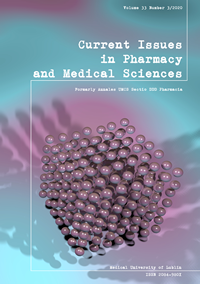The effect of a selective estrogen receptor modulator – raloxifene – on the levels of tryptophan and kynurenic acid in the livers of rats as studied via RP-HPLC-FL
DOI:
https://doi.org/10.2478/cipms-2020-0029Keywords:
ryptophan, kynurenic acid, liquid chromatography, raloxifene therapyAbstract
The levels of tryptophan (TRP) and its main metabolite kynurenic acid (KYNA) were measured in rat livers treated with raloxifene – a selective estrogen receptor modulator. The research was conducted by applying high-performance liquid chromatography on a 5 μm Zorbax Eclipse XDB-C18 column. Selective fluorescence detection (FL) was performed at an excitation of 219 nm and emission of 360 nm for TRP and KYNA.
The assays showed good linearity (R2 >0.95) within the tested ranges of 0.045-0.20 µg mL-1, 0.025-0.32 µg mL-1, respectively, for KYNA and TRP. The limits of the detection were found to be 0.1480 ng mL-1 for KYNA and 0.0332 ng mL-1 for TRP. The deproteinization of the liver homogenate samples was accomplished by 80% methanol addition combined with boiling precipitation. The average recovery values were between 94.84% and 99.54% with RSDs no more than 5.5%. The work revealed that raloxifene decreased the mean value of tryptophan, as compared with the control group, while simultaneously leaving kynurenic acid at the same level. For the first time the research suggests that, in the case of raloxifene therapy, tryptophan is not metabolized via the kynurenine pathway.
References
1. Badawy AA-B, Bano S, SteptoeA. Tryptophan in alcoholism treatment I. kynurenine metabolites inhibit the rat liver mitochondrial low Km aldehyde dehydrogenase activity, elevate blood acetaldehyde concentration and induce aversion to alcohol. Alcohol Alcohol. 2011;46:651-60.
2. Badawy AA-B, Bano S, Steptoe A. Tryptophan in alcoholism treatment II: inhibition of the rat liver mitochondrial low Km aldehyde dehydrogenase activity, elevation of blood acetaldehyde concentration and induction of aversion to alcohol by combined administration of tryptophan and benserazide. Alcohol Alcohol. 2011;46:661-71.
3. Badawy A, Morgan CJ. Rapid isocratic liquid chromatographic separation and quantification of tryptophan and six kynurenine metabolites in biological samples with ultraviolet and fluorimetric detection, Int J Tryp Res. 2010;3:175-86.
4. Chen GY, Zhong W, Zhou Z, Zhang Q. Simultaneous determination of tryptophan and its 31 catabolites in mouse tissues by polarity switching UHPLC-SRM-MS. Anal Chim Acta. 2018;1037:200-10.
5. Hervé C, Beyne P, Jamault H, Delacoux E. Determination of tryptophan and its kynurenine pathway metabolites in human serum by high-performance liquid chromatography with simultaneous ultraviolet and fluorimetric detection, J Chromatogr B. 1996;675:157-61.
6. Ma L, Xu B, Wang W, Deng W, Ding M. Analysis of tryptophan catabolism in HBV patients by HPLC with programmed wavelength ultraviolet detection, Clin Chim Acta. 2009;405:94-6.
7. Möller M, Du Preez JD, Harveya BH. Development and validation of a single analytical method for the determination of tryptophan, and its kynurenine metabolites in rat plasma. J Chromatogr B. 2012; 898:121-9.
8. Hernández-Hernández OT, Martínez-Mota L, Herrera-Pérez JJ, Jiménez-Rubio G. Role of estradiol in the expression of genes involved in serotonin neurotransmission: Implications for female depression. Curr Neuropharmacol. 2019;17:459-71.
9. Forrest CM, Kennedy A, Stone TW, Stoy N, Darlington LG. Kynurenine and neopterin levels in patients with rheumatoid arthritis and osteoporosis during drug treatment. Adv Exp Med Biol. 2003;527:287-95.
10. Norstedt G, Wrange Ö., Gustafsson J.-Å. Multihormonal regulation of the estrogen receptor in rat liver. Endocrinology. 1981;108:1190-6.
11. Hochner-Celnikier D. Pharmacokinetics of raloxifene and its clinical application. Eur J Obstet Gynecol Reprod Biol. 1999;85:23-9.
12. Paluszkiewicz P, Zgrajka W, Saran T, Schabowski J, Piedra JL, Fedkiv O, et al. High concentration of kynurenic acid in bile and pancreatic juice. Amino Acids. 2009;3(7):637-41.
Downloads
Published
Issue
Section
License
Copyright (c) 2020 Authors

This work is licensed under a Creative Commons Attribution-NonCommercial-NoDerivatives 3.0 Unported License.


